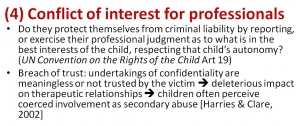Over the last few years representatives of Mandate Now have attended presentations and discussions about mandatory reporting in Regulated Activities and listened with great interest to academics, among others, justifying a position against MR grounded in large part on a report by Harries + Clare (2002) and another by Gary Melton. Below are some extracts from a presentation by Professor Laura Hoyano to an audience at the Institute of Advanced Legal Studies in 2013. Professor Hoyano’s expertise is drawn on from time to time by the NSPCC which might explain the colour used in the slides.
It’s not only Professor Hoyano who uses H+C, the Department of Education also places reliance on it as one of a small number of papers to justify its anti-mandatory mindset. But how relevant is Harries and Clare to the debate?
MN decided to research the report, not least because Western Australia, the jurisdiction used by H&C, ignored the review and adopted Mandatory Reporting in 2009 (See page 17/18)
What does the Harries and Clare report consist of ?
It appears neither Harries nor Clare have ever conducted any primary empirical research about mandatory reporting, including of sexual abuse. Their report is not primary evidence of MR making children less safe. Nor does it present a compelling case based on other material that MR makes children less safe.
Their “report” was a hastily assembled “rapid” literature review and a qualitative study seeking impressions of MR and related issues from, it seems, a non-representative sample of stakeholders. It was commissioned by a government minister ‘via the Western Australian Child Protection Council.’ Its independence is not readily apparent.
The team was given 2 months to conduct the review which is an extremely short time, and an extra 2 weeks was granted to allow for more consultation. The review included a literature review and consultation with stakeholders; but did not involve empirical research into reporting itself. The authors were both from the discipline of social work, and were supported by 8 research associates. The review is not peer reviewed or published in any recognised scholarly form and indeed neither of the two main authors appear to have published on mandatory reporting law and policy before the report, or since, in refereed journals. The review stated (p 3) that the purpose was ‘to obtain a diversity of views and, most importantly, the evidential basis for those views’ from participants. There were 158 participants. There appear to be a number of limitations in the report, including:
- The methodology is fragmented (e.g., it is not stated how data was collated, coded or analysed; and full details of participants are not disclosed)
- The legislative review is extremely limited
- There is virtually no situation of the review in the history, nature and prevalence of child abuse and neglect, or of CSA
- There is barely any distinction drawn between the different forms of child abuse and neglect, or coverage of their consequences, or of the ages at which children are most vulnerable. The types of abuse are not distinguished, nor their extents (and note there is no detailed consideration of child sexual abuse at all).
- The review spends much time representing secondary literature and repeating what these papers are represented as claiming, but it conducts no analytical work about the arguments made
- There appears to be no analysis undertaken of the secondary literature, so that any original errors in logic are simply repeated
- There is a great deal of evidence published since this paper which contradicts many of its assertions.
It can also be noted that the 158 participants were strongly supportive of MR for sexual abuse. Yet this seems to be ignored by the authors (and those who cite Harries and Clare as opposing MR for CSA).
At p. 7 of the report, the authors reported that: “Some broad generalizations can be made about the data that was obtained from stakeholders…
“4. The opinion was very strong that child sexual abuse was a critical threshold issue for reporting. In other words, for children (the term generally restricted to younger children under thirteen years) the significance and the criminality of this act was such that adults should be compelled to report it.
Melton 2005 – What relevance to Mandatory Reporting in Regulated Activities?
Prof Hoyano also mentions Melton 2005 (see slide B above) which is a paper titled ‘Mandatory Reporting A Policy without Reason.’ It features in a Mandate Now presentation not least because we agree with a good deal of what it says. You might wonder why given the title:
- His thesis is completely unrelated to and inapplicable to child sexual abuse either generally or only in regulated activities/institutions – it is significant that he has never responded to the critiques of the 2005 work
- Several articles have been written in response to Melton namely: Mathews and Bross ‘Mandated reporting is still a policy with reason: empirical evidence and philosophical grounds’
- Drake and Jonson-Reid article in response to Melton 2007 – also a direct response to Melton
Quite why Harries and Clare or Melton are treated with such authority by those who oppose mandatory reporting of abuse in Regulated Activities is unclear. The evidence does not seem able to bear the weight of opinion which appears to rely on them.



